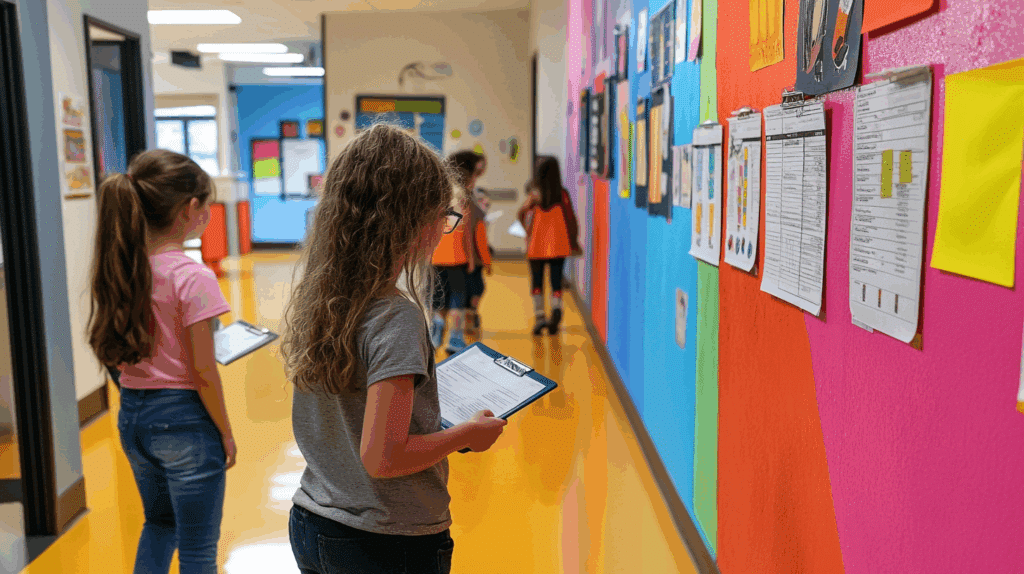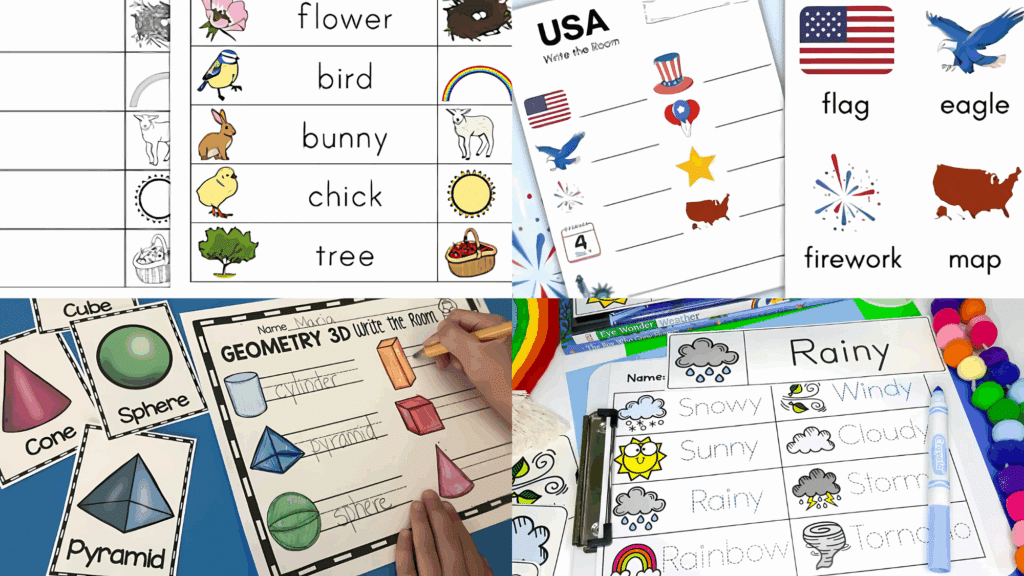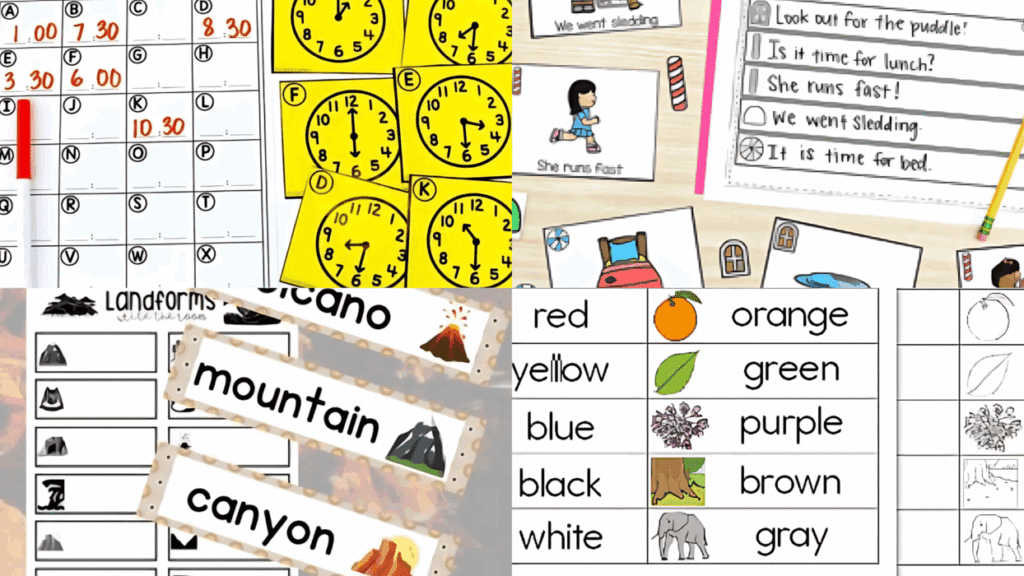Tired of students who scan content but miss key points? Attention spans wane when lessons lack engagement. Teachers face this challenge daily in classrooms worldwide.
But what if students could move around while learning?
“Write the room” turns passive readers into active participants. This teaching method lets students get up, walk around, and find information posted on walls – then write down what they learn.
This guide shows how to set up write-the-room activities, offers practical ideas for different subjects, and shares tips to help the method work for all students. Read on to learn more!
What is Write the Room?

Write the room is a teaching method where teachers post information around the classroom walls. Students then walk around with clipboards or papers to find and note down this information.
The concept is simple yet effective. Teachers place cards, notes, or images with facts or questions on walls, bulletin boards, and other surfaces in the classroom.
Students move freely around the space, stopping at each posting to read and respond. This process combines physical movement with mental work, which helps many students stay focused and learn better.
Think of it as a classroom scavenger hunt with a learning twist. The goal isn’t just finding items but taking in knowledge while being active.
Write the Room: A Game-Changer for Learning

The method helps students take in information better. Write the room works because it mixes movement with learning in ways that benefit students of all types.
- Physical activity boosts focus: When students move around, blood flow increases to their brains. This helps them pay more attention to what they’re learning instead of zoning out at their desks.
- Multiple learning styles addressed: This technique helps visual learners see information, kinetic learners move while learning, and reading/writing learners take notes – all at once.
- Memory improvement occurs: The act of finding information, reading it, and writing it down creates stronger brain connections than just hearing facts.
- Classroom energy shifts: The change in routine breaks monotony and wakes up tired minds. Students look forward to these active sessions.
- Student independence grows: Learners work at their own pace and follow their own paths around the room, building self-direction skills.
Fun and Engaging Write the Room Ideas for Kids

Looking for ways to make learning stick?
Write the room offers countless options to turn basic facts into fun hunts that kids love:
1. Vocabulary Scavenger Hunt
This activity encourages students to look around the room while searching for vocabulary words.
Each student finds words related to the subject matter and writes them down. It’s a fun way to enhance their word recognition and understanding.
- What you’ll need: Vocabulary list, paper, pen
- Instructions: Place vocabulary words around the room. Have students find and write them down. Ask them to use each word in a sentence.
2. Math Problem Hunt
In this activity, students find math problems scattered throughout the room. They solve each problem and write the answers down. It helps reinforce math skills and allows for active participation.
You can mix addition, subtraction, multiplication, or division.
- What you’ll need: Math problems, paper, pencil
- Instructions: Hide math problems in various spots. Students find and solve each problem, writing down answers.
3. Spelling Bee Walk
Students search for misspelled words hidden around the room and correct them. This is a great way to practice spelling skills and improve attention to detail.
It works especially well in language arts classrooms. Make it competitive by timing each student or team.
- Instructions: Write incorrect words around the room. Students find them and rewrite the correct spelling.
4. Science Term Match
This Write the Room activity focuses on science vocabulary. Students look for terms related to their current unit, then match them with definitions. It encourages both movement and learning.
You can use terms from biology, chemistry, physics, or earth science.
- What you’ll need: Science terms and definitions, paper, pen
- Instructions: Place terms and definitions around the room. Students match the term with its definition and write the pair.
5. History Timeline Hunt
This activity involves placing historical events around the room, where students must order them on a timeline.
It helps reinforce historical knowledge while giving students the chance to move around. It’s ideal for history or social studies classes.
- What you’ll need: Events on paper, timeline template
- Instructions: Place historical events in the room. Have students put them in chronological order.
6. Shape and Geometry Search
Hide pictures of different shapes and geometric figures throughout the room. Students will find and write down their properties. This works well for reinforcing geometry skills and spatial awareness.
- What you’ll need: Shape cutouts, paper, pen
- Instructions: Hide pictures of shapes around the room. Students identify and write down their properties.
7. Science Experiment Observation
Students look for stations that describe different science experiments. At each station, they write down the materials and procedure.
This activity promotes active learning and helps students remember scientific methods.
- What you’ll need: Experiment descriptions, paper, pen
- Instructions: Place experiment descriptions around the room. Students write down materials and procedures.
8. Famous Person Search
This activity involves students searching for facts about famous people in history or science.
They write down key facts such as their achievements, birthdates, and impact. It’s a fun way to get students engaged with history or biography lessons.
- What you’ll need: Famous person facts, paper, pen
- Instructions: Place famous person facts around the room. Students find the facts and write down key details.
9. Animal Classification Race
Hide images or names of animals around the room. Students must classify the animals into categories like mammals, reptiles, birds, etc. This activity strengthens biology knowledge and classification skills.
- What you’ll need: Animal images or names, paper, pen
- Instructions: Place animal names/images around the room. Students classify them and write down the category.
10. Literary Devices Hunt
Students look for literary devices hidden in various short passages around the room. They identify examples like metaphors, similes, and personification. This activity enhances their understanding of literature and encourages close reading.
- What you’ll need: Excerpts with literary devices, paper, pen
- Instructions: Place short passages around the room. Students identify the literary device in each passage.
11. Chemistry Element Search
Place different elements from the periodic table around the room with their symbols and atomic numbers. Students must find the elements and write down their names. This activity is perfect for reviewing chemistry concepts.
- What you’ll need: Element cards, paper, pen
- Instructions: Place elements around the room. Students write down their full names and atomic numbers.
12. Weather Observation Hunt
Students search for weather-related terms or symbols hidden in the room.
They write down the definition or draw the related symbol. This activity helps reinforce their understanding of meteorology. It’s a great way to make science feel interactive and fun.
- What you’ll need: Weather symbols or terms, paper, pen
- Instructions: Place weather terms or symbols around the room. Students write or draw the corresponding definitions or images.
13. Pronoun and Verb Match
This game involves placing pronouns and verbs around the room, and students need to find and match them correctly. It’s a great way to reinforce grammar.
You can focus on different verb tenses or pronoun types depending on your lesson.
- What you’ll need: Pronouns, verbs, paper, pen
- Instructions: Place pronouns and verbs around the room. Students match them and use them in a sentence.
When you change up your write the room setup often, students will stay eager to see what’s new on the walls each week.
Write the Room Activities for Every Subject

No matter what you teach, write the room fits right in. This method works for math facts, spelling words, science terms, and more.
14. Adjective Activities
In this activity, students find objects around the room and write down adjectives that describe them. It helps them practice using descriptive language and expands their vocabulary. You can focus on adjectives related to appearance, texture, color, or size.
- What you’ll need: List of objects, paper, pen
- Instructions: Place objects around the room. Students write adjectives to describe each one.
15. Time-Telling Challenge
Students look for clocks or time-related terms around the room. They write down the time or define the time term they find. It’s an excellent activity for practicing reading analog clocks or understanding time-related vocabulary.
- What you’ll need: Clocks, time-related terms, paper, pen
- Instructions: Place clocks and terms around the room. Students write down the time or definitions.
16. Punctuation Hunt
Hide different punctuation marks around the room, along with examples of sentences missing them. Students must write down the correct punctuation mark for each sentence.
This activity reinforces grammar skills, specifically punctuation.
- What you’ll need: Punctuation marks and sentence strips, paper, pen
- Instructions: Place sentences around the room. Students identify and add the correct punctuation mark.
17. Art Term Findings
This activity has students searching for art-related terms, such as “hue,” “texture,” and “perspective.” They write down the definition or draw an example. It’s a fantastic way to merge creativity with vocabulary learning.
- What you’ll need: Art terms, paper, pen
- Instructions: Place art terms around the room. Students write down the definition or draw an example.
18. Geography Location Search
Hide various countries, cities, and landmarks around the room.
Students will locate them on a world map and write down their geographical details. This activity is great for reinforcing global knowledge and map skills.
- What you’ll need: List of countries, cities, landmarks, paper, pen
- Instructions: Place location names around the room. Students locate them on the map and write details.
19. Fraction Search
Students will look for fraction problems hidden around the room. They must solve each problem and write down the answer as both a fraction and a decimal.
This activity reinforces math concepts related to fractions.
- What you’ll need: Fraction problems, paper, pencil
- Instructions: Hide fraction problems around the room. Students solve and write down answers in different forms.
20. Synonym and Antonym Hunt
Place words around the room, and students need to find synonyms or antonyms for each word.
This activity is fantastic for building vocabulary. It encourages students to think critically about words and their meanings.
- What you’ll need: Word cards, paper, pen
- Instructions: Place words around the room. Students write synonyms or antonyms for each word.
21. Color Word Task
In this activity, students find color words hidden in the room and write them down in rainbow order. You can also have them identify objects of that color.
It’s a fun way to engage younger learners with both language and color recognition.
- What you’ll need: Color word cards, paper, pen
- Instructions: Place color word cards around the room. Students write the color words in rainbow order.
Tips for Teachers for Write the Room Activties

Making this activity work well takes some planning. Here are ways teachers can set up write-the-room activities that keep students interested and learning effectively:
- Place materials at different heights to make sure all students can access them easily.
- Use clear fonts and good-sized text that can be read from a short distance away.
- Include pictures along with words for younger students or language learners.
- Change the content regularly to keep the walls fresh and exciting.
- Color-code materials by subject or difficulty level to help students find what they need.
- Add a time limit that pushes students to work but isn’t too stressful.
- Give students special clipboards or recording sheets to make the task feel important.
With these small but helpful steps, teachers can make write the room activities run smoothly. Students will know what to do and can focus on the learning rather than figuring out the task.
Wrapping It Up
Getting students to truly learn concepts can be hard. Write the room takes learning off the page and puts it into action.
This teaching method turns walls into learning tools and helps facts stick in students’ minds.
Have you tried this method before? What worked best for your students?
Share your experiences in the comments section below – your tips might help another teacher’s classroom come alive!




